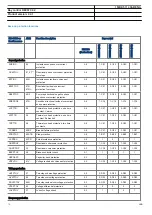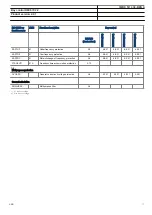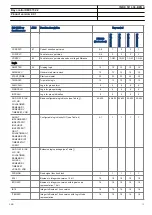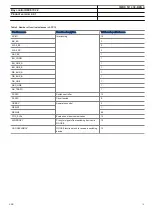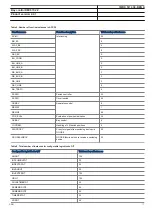
1. Application
M13637-3 v13
The Intelligent Electronic Device (IED) is used for the control,
protection and monitoring of different types of bays in power
networks. The IED is especially suitable for applications in
control systems where the IEC 61850–8–1 Ed 1 or Ed 2
station bus features of the IED can be fully utilized. It is used
for station-wide interlocking via GOOSE messages and
vertical client-server MMS communication to a local station or
remote SCADA operator workplace. This supports the
architecture with distributed control IEDs in all bays with high
demands on reliability. Redundant communication is obtained
through the built-in PRP and HSR features which can be used
in star or ringbus architectures. The IED can be used on all
voltage levels. It is suitable for the control of all apparatuses
in any type of switchgear arrangement.
The control is performed from remote (SCADA/Station)
through the IEC 61850–8–1 Ed1 or Ed2 station
communication or from the built-in multi-display local HMI.
Cyber security measures are implemented to secure safe
autonomous operation of the protection and control functions
even if simultaneous cyber attacks occur. For all common
types of switchgear arrangements, there are different pre-
configurations for control and interlocking. One control IED
can be used for single bay or multi-bay applications. The
control operation is based on the select-before-execute
principle to give highest possible security. There are
synchrocheck functions available to assist optimal breaker
closing at the right instance in synchronous as well as
asynchronous networks.
A number of protection functions are available for flexibility in
use for different station types and busbar arrangements. To
fulfil the user's application requirements, the IED features, for
example, up to six instantaneous phase and earth overcurrent
functions, 4–step directional or non-directional delayed-phase
and earth overcurrent functions, thermal overload and
frequency functions, two instances of 2–step under- and
overvoltage functions, autorecloser functions and several
different measuring functions. This, together with the multi-
display local HMI that can show one or more pages per
feeder allows using the IED for protection and control for up
to six bays in a substation.
The auto-reclose for single-, two-, and/or three-phase reclose
includes priority circuits for multi-breaker arrangements. It co-
operates with the synchrocheck function with high-speed or
delayed reclosing. Several breaker failure functions are
available to provide a breaker failure function independent
from the protection IEDs, also for a complete one- and a half
breaker diameter.
Disturbance recording and fault locator are available to allow
independent post-fault analysis after primary disturbances in
case of a failure in the protection system.
Duplex communication channels for transfer of up to 192
intertrip and binary signals are available on each remote-end
data communication card (LDCM). Typical applications are
the communication between IEDs inside the station or with
IEDs in a remote station as remote I/O.
The IED can be used in applications with the IEC/UCA
61850-9-2LE process bus with up to eight Merging Units
(MU). Each MU has eight analogue channels, four current and
four voltages. Conventional input transformer module and
Merging Unit channels can be mixed freely in your application.
Logic is prepared with a graphical tool. The advanced logic
capability allows special applications such as automatic
opening of disconnectors in multi-breaker arrangements,
closing of breaker rings, load transfer logics and so on. The
graphical configuration tool ensures simple and fast testing
and commissioning.
Forcing of binary inputs and outputs is a convenient way to
test wiring in substations as well as testing configuration logic
in the IEDs. Basically it means that all binary inputs and
outputs on the IED I/O modules (BOM, BIM, IOM & SOM) can
be forced to arbitrary values.
Central Account Management is an authentication
infrastructure that offers a secure solution for enforcing
access control to IEDs and other systems within a substation.
This incorporates management of user accounts, roles and
certificates and the distribution of such, a procedure
completely transparent to the user.
Flexible Product Naming allows the customer to use an IED-
vendor independent IEC 61850 model of the IED. This
customer model will be used as the IEC 61850 data model,
but all other aspects of the IED will remain unchanged (e.g.,
names on the local HMI and names in the tools). This offers
significant flexibility to adapt the IED to the customers'
system and standard solution.
SEMOD51278-4 v11
Four packages have been defined for following applications:
• Single breaker (double or single bus) arrangement (A30)
• Double breaker arrangement (B30)
• 1 ½ breaker arrangement for a complete diameter (C30)
• Single breaker (double bus) arrangement with PMU
functionality (D30)
Optional functions are available in PCM600 Application
Configuration Tool and can be configured by the user.
Interface to analog and binary IO:s are configurable without
need of configuration changes. Analog and control circuits
have been pre-defined. Other signals need to be applied as
required for each application. The main differences between
the packages above are the interlocking modules and the
number of apparatuses to control.
1MRK 511 404-BEN A
Bay control REC670 2.2
Product version: 2.2.1
Issued: October 2017
Revision: A
ABB
3










